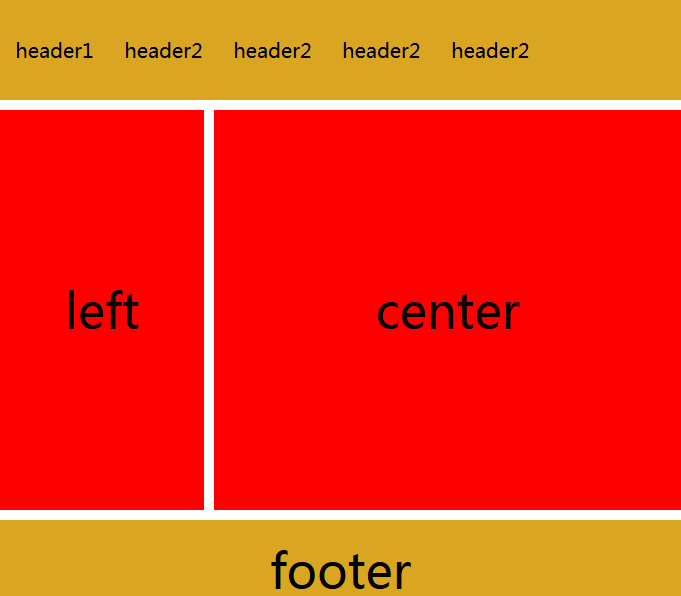用CSS实现响应式布局
响应式网页看起来高大上,但实际上,不用JS只用CSS也能实现响应式网站的布局
要用到的就是CSS中的媒体查询下面来简单介绍一下怎么运用
使用@media 的三种方式
第一: 直接在CSS文件中使用
@media 类型 and (条件1) and (条件二)
{
css样式
}
@media screen and (max-width:980px ) {
body{
}
}
第二:使用@import导入
@import url("css/moxie.css") all and (max-width:980px);
第三,也是最常用的:使用link连接,media属性用于设置查询方式
<link rel="stylesheet" type="text/css" href="css/moxie.css" media=“all and (max-width=980px)”/>
我们只需用到width衍生出的max-width这个属性,定义输出设备中的页面可见区域宽度来控制该改变的样式即可。
下面是一个简单响应式的布局的html代码
<!DOCTYPE html>
<html>
<head>
<meta charset="UTF-8">
<title>响应式布局</title>
<meta name="viewport"content="width=device-width,initial-scale=1.0,maximum-scale=1,user-scalable=no" />
<meta name="format-detection" content="telephone=no,email=no"/>
<link rel="stylesheet" type="text/css" href="css/mo2.css"/>
</head>
<body>
<div>
<header id="head">
<ul>
<li>header1</li>
<li>header2</li>
<li>header2</li>
<li>header2</li>
<li>header2</li>
</ul>
<div>icon</div>
</header>
<section id="main">
<div class="left">
left
</div>
<div class="center">
center
</div>
<div class="right">
right
</div>
</section>
<footer id="foot">
footer
</footer>
</div>
</body>
</html>
下边是CSS样式
*{
margin: 0px;
padding: 0px;
font-family: "微软雅黑";
}
#head,
#foot,
#main
{
height: 100px;
width: 1200px;
/*width: 85%;*/
background-color: goldenrod;
text-align: center;
font-size: 48px;
line-height: 100px;
margin: 0 auto;
}
#head div{
display: none;
font-size: 20px;
height: 30px;
width: 100px;
background-color: green;
float: right;
line-height: 30px;
margin-top: 35px;
}
#head ul{
width: 80%;
}
#head ul li{
width: 20%;
float: left;
text-align: center;
list-style: none;font-size: 20px;
}
#main{
height: auto;
margin: 10px auto;
overflow: hidden;
}
.left,
.center,
.right{
height: 600px;
line-height: 600px;
float: left;
width: 20%;
background-color: red
}
.center{
width: 60%;
border-left: 10px solid #FFF;
border-right: 10px solid #FFF;
box-sizing: border-box;
}
@media only screen and (max-width: 1200px) {
#head,
#foot,
#main{
width: 100%;
}
}
@media only screen and (max-width: 980px) {
.right{
display: none;
}
.left{
width: 30%;
}
.center{
width: 70%;
border-right: hidden;
}
}
@media only screen and (max-width: 640px) {
.left,
.center,
.right{
width: 100%;
display: block;
height: 200px;
line-height: 200px;
}
.center{
border: hidden;
border-top: 10px solid #FFFFFF;
border-bottom: 10px solid #FFFFFF;
height: 600px;
line-height: 600px;
}
#head ul{
display: none;
}
#head div{
display: block;
}
}
窗口大于1200px时显示的样子

窗口小于1200大于980时,只会被压缩,并不会发生其他变化

当大于640小于980时,右侧栏隐藏

当小于640时,导航栏折叠,body三部分竖直排列显示,若窗口持续缩小,不在发生变化,区域被压缩

好了,布局就这么简单,细节的把握还靠不断地练习。
响应式网页看起来高大上,但实际上,不用JS只用CSS也能实现响应式网站的布局
要用到的就是CSS中的媒体查询下面来简单介绍一下怎么运用
使用@media 的三种方式
第一: 直接在CSS文件中使用
@media 类型 and (条件1) and (条件二)
{
css样式
}
@media screen and (max-width:980px ) {
body{
}
}
第二:使用@import导入
@import url("css/moxie.css") all and (max-width:980px);
第三,也是最常用的:使用link连接,media属性用于设置查询方式
<link rel="stylesheet" type="text/css" href="css/moxie.css" media=“all and (max-width=980px)”/>
我们只需用到width衍生出的max-width这个属性,定义输出设备中的页面可见区域宽度来控制该改变的样式即可。
下面是一个简单响应式的布局的html代码
<!DOCTYPE html>
<html>
<head>
<meta charset="UTF-8">
<title>响应式布局</title>
<meta name="viewport"content="width=device-width,initial-scale=1.0,maximum-scale=1,user-scalable=no" />
<meta name="format-detection" content="telephone=no,email=no"/>
<link rel="stylesheet" type="text/css" href="css/mo2.css"/>
</head>
<body>
<div>
<header id="head">
<ul>
<li>header1</li>
<li>header2</li>
<li>header2</li>
<li>header2</li>
<li>header2</li>
</ul>
<div>icon</div>
</header>
<section id="main">
<div class="left">
left
</div>
<div class="center">
center
</div>
<div class="right">
right
</div>
</section>
<footer id="foot">
footer
</footer>
</div>
</body>
</html>
下边是CSS样式
*{
margin: 0px;
padding: 0px;
font-family: "微软雅黑";
}
#head,
#foot,
#main
{
height: 100px;
width: 1200px;
/*width: 85%;*/
background-color: goldenrod;
text-align: center;
font-size: 48px;
line-height: 100px;
margin: 0 auto;
}
#head div{
display: none;
font-size: 20px;
height: 30px;
width: 100px;
background-color: green;
float: right;
line-height: 30px;
margin-top: 35px;
}
#head ul{
width: 80%;
}
#head ul li{
width: 20%;
float: left;
text-align: center;
list-style: none;font-size: 20px;
}
#main{
height: auto;
margin: 10px auto;
overflow: hidden;
}
.left,
.center,
.right{
height: 600px;
line-height: 600px;
float: left;
width: 20%;
background-color: red
}
.center{
width: 60%;
border-left: 10px solid #FFF;
border-right: 10px solid #FFF;
box-sizing: border-box;
}
@media only screen and (max-width: 1200px) {
#head,
#foot,
#main{
width: 100%;
}
}
@media only screen and (max-width: 980px) {
.right{
display: none;
}
.left{
width: 30%;
}
.center{
width: 70%;
border-right: hidden;
}
}
@media only screen and (max-width: 640px) {
.left,
.center,
.right{
width: 100%;
display: block;
height: 200px;
line-height: 200px;
}
.center{
border: hidden;
border-top: 10px solid #FFFFFF;
border-bottom: 10px solid #FFFFFF;
height: 600px;
line-height: 600px;
}
#head ul{
display: none;
}
#head div{
display: block;
}
}
窗口大于1200px时显示的样子

窗口小于1200大于980时,只会被压缩,并不会发生其他变化

当大于640小于980时,右侧栏隐藏

当小于640时,导航栏折叠,body三部分竖直排列显示,若窗口持续缩小,不在发生变化,区域被压缩

好了,布局就这么简单,细节的把握还靠不断地练习。